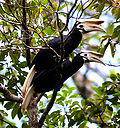Anthracoceros
| Anthracoceros | |
|---|---|

| |
| Oriental pied hornbill (Anthracoceros albirostris) | |
| Scientific classification | |
| Kingdom: | Animalia |
| Phylum: | Chordata |
| Class: | Aves |
| Order: | Bucerotiformes |
| Family: | Bucerotidae |
| Genus: | Anthracoceros Reichenbach, 1849 |
| Species | |
|
Anthracoceros coronatus | |
Anthracoceros is a genus of birds in the family Bucerotidae.
The genus was introduced by the German naturalist Ludwig Reichenbach in 1849.[1] The type species was subsequently designated as the Malabar pied hornbill (Anthracoceros coronatus).[2][3] The name is a combination of the Ancient Greek words ανθραξ anthrax, ανθρακος anthrakos meaning "coal black" and κερας keras, κερως kerōs meaning "horn".[4] A molecular phylogenetic study published in 2013 found that Anthracoceros was sister to the genus Ocyceros which contains the three grey hornbill species.[5]
The genus contains five species:[6]
| Image | Scientific name | Common Name | Distribution |
|---|---|---|---|
 |
Anthracoceros coronatus | Malabar pied hornbill | India and Sri Lanka |
 |
Anthracoceros albirostris | Oriental pied hornbill | Bangladesh, Bhutan, Brunei, Cambodia, China (Guangxi, Yunnan and Tibet), Eastern and Northern India, Indonesia, Laos, Malaysia, Myanmar, Nepal, Singapore, Thailand and Vietnam |
 |
Anthracoceros malayanus | Black hornbill | Asia in Brunei Darussalam, Indonesia, Malaysia, Singapore, Thailand. |
 |
Anthracoceros marchei | Palawan hornbill | Palawan island |
| Anthracoceros montani | Sulu hornbill | Philippines |
References[]
- ^ Reichenbach, Ludwig (1849). Avium Systema Naturale (in German). Dresden and Leipzig: Friedrich Hofmeister. Plate XLIX.
- ^ Peters, James Lee, ed. (1945). Check-list of Birds of the World. Vol. Volume 5. Cambridge, Massachusetts: Harvard University Press. p. 266.
{{cite book}}:|volume=has extra text (help) - ^ Dickinson, E.C.; Remsen, J.V., Jr., eds. (2013). The Howard & Moore Complete Checklist of the Birds of the World. Vol. Volume 1: Non-passerines (4th ed.). Eastbourne, UK: Aves Press. p. 284. ISBN 978-0-9568611-0-8.
{{cite book}}:|volume=has extra text (help) - ^ Jobling, J.A. (2019). del Hoyo, J.; Elliott, A.; Sargatal, J.; Christie, D.A.; de Juana, E. (eds.). "Anthracoceros". Handbook of the Birds of the World Alive: Key to Scientific Names in Ornithology. Lynx Edicions. Retrieved 23 July 2019.
- ^ Gonzalez, J.-C.T.; Sheldon, B.C.; Collar, N.J.; Tobias, J.A. (2013). "A comprehensive molecular phylogeny for the hornbills (Aves: Bucerotidae)". Molecular Phylogenetics and Evolution. 67 (2): 468–483. doi:10.1016/j.ympev.2013.02.012.
- ^ Gill, Frank; Donsker, David, eds. (2019). "Mousebirds, Cuckoo Roller, trogons, hoopoes, hornbills". World Bird List Version 9.2. International Ornithologists' Union. Retrieved 23 July 2019.
Categories:
- Anthracoceros
- Bird genera
- Taxa named by Ludwig Reichenbach
- Coraciiformes stubs